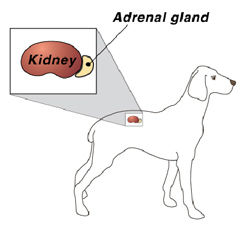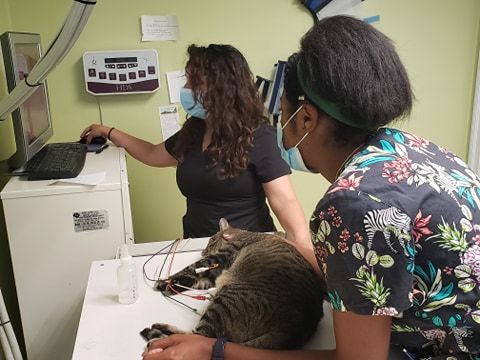Find Your Store
Conventional medicine
.jpg)
Imagine what your mouth would feel like if you never brushed your teeth or went to the dentist. For many dogs and cats, this is a painful reality. According to the American Veterinary Dental Society, more than 80% of dogs and 70% of cats have dental disease by the age of 3. Dental (or periodontal) disease is the most frequently diagnosed health problem in pets.
Common signs of dental disease include:
- Yellow or brown buildup (tartar) on the teeth
- Red, swollen, or bleeding gums
- Bad breath
- Excessive drooling
- Changes in eating or chewing habits
- Pawing at the face
- Loose teeth
- Depression
Even if your dog or cat doesn’t have these symptoms, we recommend that you have a veterinarian evaluate your pet’s dental health at least once a year. Bacteria and food debris accumulate around the teeth and, if left unchecked, will lead to deterioration of the soft tissue and bone surrounding the teeth. This decay can result in irreversible periodontal disease, tooth loss, and possibly expensive oral surgery.
Our team is highly trained in performing various dental procedures:
>Cleaning / Scaling
>Polishing
>Extractions
>Dental Radiographs
>Suturing
We also work with Houndstooth Non-Anesthetic Dental (NAD) cleaning services. A NAD cleaning is where a specially trained dental technician cleans your pet's teeth with no anesthesia. This is an excellent choice for cats and dogs sensitive to sedation due to health complications or old age.
Our veterinary technicians have learned the NAD cleaning technique, and we now perform cleanings every Friday.
Schedule your pet’s dental exam today! We can also help show you how to brush your pet’s teeth and recommend foods and treats that will help combat plaque and tartar buildup.

When we need to figure out what’s wrong with your pet, we routinely use x-rays to help identify the cause of the problem, rule out possible problems, or provide a list of possible causes. We may also use x-rays during a wellness exam to diagnose potential problems before they become serious.
X-rays provide valuable information about a pet’s bones, gastrointestinal tract (stomach, intestines, colon), respiratory tract (lungs), heart, and genitourinary system (bladder, prostate).
To avoid a blurry image, pets need to remain completely still while an x-ray is taken. In some cases, we may need to sedate your pet or use short-acting general anesthesia.
We are also affiliated with the PennHIP method of radiology. PennHIP testing is a series of radiographs to assess if your pet is suffering from osteoarthritis or hip dysplasia. For more information on PennHIP procedures, visit their website 'here.'
If you have any questions about our radiology service or what to expect during your pet’s procedure, please don’t hesitate to ask.

A flea problem on your pet means a flea problem in your home. Understanding the flea life cycle and methods for its control can be a daunting task. We will gladly assist you in this process. We can provide you with safe, effective flea prevention and if necessary, flea treatment.

It is crucial for your pet’s vision that we detect and treat glaucoma and other problems with intraocular pressure (pressure within the eye) as quickly as possible. We can test your dog or cat’s eyes for excess pressure easily and safely with a device called a tonometer.
Pets that have suffered eye injured as well as breeds that are prone to developing glaucoma should come in for regular measurements so we can monitor eye pressure and begin treatment before any problem becomes irreversible.
Call us right away if you notice any of the following problems in either or both of your pet’s eyes: dilated (enlarged) pupils, clouding of the cornea (the normally clear outer layer of the eye), red or bloodshot eyes, one eye protruding or appearing larger than the other, squinting, or tearing. Because glaucoma is painful, your pet may react by rubbing or pawing at the eyes or rubbing his or her head against the floor or furniture more than normal.

Ultrasonography (also called ultrasound or sonography) is a non-invasive, pain-free procedure that uses sound waves to examine a pet's internal organs within the body. It can be used to evaluate the animal's heart, kidneys, liver, bladder; detect fluid, cysts, tumor; and confirm pregnancy or monitor an ongoing pregnancy.
We are teamed with Metropolitan Veterinary Radiology, who comes to our clinic on scheduled dates when a Doctor recommends the procedure.
The Ultrasonographer and a Veterinary Technician will shave a small patch of hair off the pet for precise results, applies gel to the surface of the body and methodically moves a transducer (small handheld device) across the skin to record images of the area of interest. The gel helps the transducer slide more easily and create more accurate visual images.
The transducer emits ultrasonic sound waves, which are directed into the body toward the structures examined. The waves create echoes of varying degrees, depending on the density of the tissue and amount of fluid present. Those waves create detailed images of the structures which are shown on a monitor and recorded for evaluation.
Once the images have been recorded, the Ultrasonographer speaks with the Attending Veterinarian, who then will speak with you about their findings and further diagnostic plans.

Identifying endocrine problems as early as possible is important in dogs and cats. These serious, potentially life-threatening conditions are much more manageable when caught early, allowing us to begin proper treatment.
The endocrine system is made up of a group of tissues (mostly glands) that release hormones into the bloodstream. These hormones regulate metabolism, growth, development, and reproduction and are dispersed to different areas of the body, depending on the hormone’s function. When a hormonal balance is disturbed (by a tumor or autoimmune disease, for instance), an endocrine disorder can develop. “Hyper” refers to an excess of hormone, and “hypo” refers to a deficiency in a hormone. Treatment varies depending on the disease.
There are several common endocrine disorders found in dogs and cats:
- Diabetes mellitus is caused by a deficiency in or resistance to the hormone insulin.
- Hypothyroidism, which is often diagnosed in dogs, indicates that the animal has low levels of thyroid hormone.
- Hyperthyroidism, which frequently affects cats, indicates that the animal has high levels of thyroid hormones.
- Addison’s disease (hypoadrenocorticism) and Cushing’s disease (hyperadrenocorticism) can also affect both species, although Cushing’s disease is rare in cats.
Contact us if your pet begins panting excessively, develops any skin issues (such as hair loss or dull coat), or shows any changes in behavior, energy levels, appetite, weight, water consumption, or urination.

Everyone gets older over time, and in our older age, the body slows down. In many cases, simple issues the body was able to contend with on its own previously, become diseases because the body is unable to continue fighting and regenerating like it once did. Our Senior Testing Package is our most thorough and comprehensive check-up package where we run several tests on your pet to make sure they are functioning at peak efficiency.
It is a safe and cost-effective preventative care for middle-aged pets to determine if they are having difficulties with any hidden weaknesses; as well as an excellent check-up for senior pets to ensure they are still living their best quality of life.
The package includes:
Whole Body Radiographs (X-rays) to check your pet’s muscles, joints and bones.
Blood Pressure determines if your pet’s blood is pumping at a normal rate through their body
Electrocardiogram (EKG/ECG) checks your pet’s heart rate is beating within normal and healthy levels
Eye Tonometry checks your pet’s eye pressure for any signs of deterioration or glaucoma
How painful is it living with a knot in your back or brushing your hair out with tangles/split ends? Our pets get the same level of discomfort when their hair/fur is completely matted. These knots are painful to live with and make the most relaxed pets hostile from sheer, constant irritability. Some grooming salons are not entirely equipped to handle certain pets or their issues but, we are.
When knots are formed, it doesn’t allow the skin to “breathe”, which can trap in dirt and moisture. This dirt could be laced with bacteria or fungi, which will spread and cause harm to your pet’s skin and overall health. Many times, knots can cover wounds like cuts that become infected over time.
Our facility and staff are trained to find and untangle knots and mats and ear cleaning. We also perform anal gland expression and ear cleaning.
Microchipping is a safe, permanent way to identify your pet in case he or she becomes lost. A microchip is a tiny device about the size and shape of a grain of rice, is placed just under the loose skin at the back of the neck. When a lost dog or cat without an ID tag is found, a veterinarian will use a handheld microchip scanner to check for a chip. If the pet has one, it will transmit its ID number to the scanner via a low-frequency radio wave. The veterinary hospital or shelter then calls the chip manufacturer, retrieves the pet owner’s contact information and calls the owner.
Even the most responsible pet owners can’t always guarantee their pet won’t get lost. A leash could break or slip out of your hand, a pet could push through a screen door or window, or a contractor or friend might accidentally leave a door or gate open.
We recommend that you use a microchip, along with a collar and ID tag, to identify your pet. An ID tag is still a reliable identification method. Pets that have tags with current contact information are more likely to not end up in shelters and tend to get home faster than those without tags. However, collars and ID tags aren’t permanent and can be removed (overnight or for grooming); pets can also lose them. With a microchip, your pet will have a much better chance of being identified and returned to you. Pets without microchips that end up in shelters may be adopted out to another family or even euthanized.
Please contact us to schedule an appointment to microchip your pet. Although we hope your pet never becomes lost, we want you to be prepared. We can also suggest a plan to have in place so if your pet does go missing, you’ll be able to act quickly.
What Our Customers Say
Our clients come from New Jersey, Manhattan, Staten Island, Westchester County, Eastern Pennsylvania, and beyond! If you are further away, please call us about telehealth consultations for your pet.









